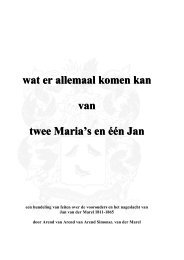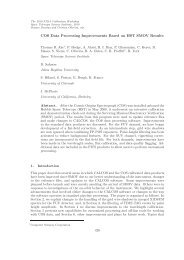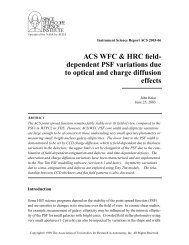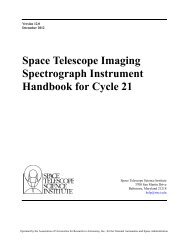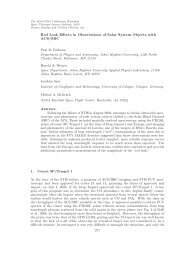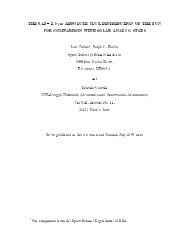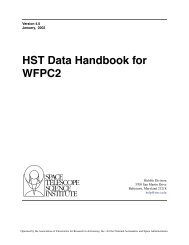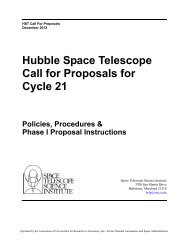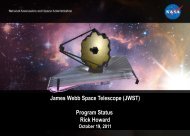STScI Annual Report 2002: A Living Mission
STScI Annual Report 2002: A Living Mission
STScI Annual Report 2002: A Living Mission
You also want an ePaper? Increase the reach of your titles
YUMPU automatically turns print PDFs into web optimized ePapers that Google loves.
stand the audiences that use the online materials. We also developed a data collection program for<br />
tracking how our educational products are used.<br />
The astronomy education community submitted 51 IDEAS proposals in <strong>2002</strong>, which was a 29%<br />
increase in participation from 2001. The 13 winning proposals were awarded a total of $430K. The community<br />
submitted 15 Education and Public Outreach proposals in connection with Cycle 11, representing<br />
27 science programs and 2 Hubble Fellows. Following peer review, we selected 11 proposals and awarded<br />
$220K. Our education team also collected and analyzed final reports for IDEAS grants to ascertain the<br />
impact of that program. The OPO External Advisory Group reviewed this evaluation effort positively and<br />
recommended its continuation.<br />
Online outreach<br />
Our Online Outreach Program provides a suite of resources for disseminating key scientific results to the<br />
general public. Our premier online site, Hubblesite, received more than 19 million visitors over the year.<br />
We updated Hubblesite to inform visitors about the servicing mission, SM3b. We also updated Hubblesite<br />
with a full suite of information on ACS. We developed a new feature in Hubblesite’s ‘discoveries’ section.<br />
Entitled “Striking Encounters”, it showcased the ACS science capabilities for understanding colliding<br />
galaxies as illustrated by the ERO image of the ‘Mice’ galaxies.<br />
With an unprecedented number of visitors drawn by the first ACS images, the OPO web servers<br />
became completely subscribed only 20 minutes into the ACS ERO press conference. The Online Outreach<br />
team worked around the clock to handle the extreme load. We distributed to a server farm at seven other<br />
locations, including NASA HQ and the Kennedy, Johnson, Ames, and Goddard centers. In six days we took<br />
more than 40 million hits and transferred half a terabyte of data from the OPO servers alone.<br />
We worked extensively with the News team to develop the Press Release e-Servicing System (PReSS) for<br />
archiving all Hubble news material. We also updated the James Webb Space Telescope (JWST) public website.<br />
Informal science education<br />
The OPO Informal Science Education Program assists museums, science centers, and planetariums to<br />
showcase and explain Hubble discoveries and images. We offer science-content review and consultation<br />
to informal science education organizations that are developing exhibitions and programs.<br />
A major component of our program is ViewSpace, which is a unique multimedia product for largescreen<br />
video display in museums and planetariums. Using colorful images, digital movie clips, and simple<br />
language in captions, ViewSpace tells Hubble science stories. Host institutions provide their own playback<br />
system, which can consist of an inexpensive PC and image projector. We provide ViewSpace on CD at no<br />
cost. The science museum community has welcomed ViewSpace, which was active at over 100 sites in <strong>2002</strong>.<br />
We produced a short video mini-documentary, “Hubble Reborn”, which dramatically depicts the<br />
challenges faced by space shuttle astronauts on SM3b. It culminates in the release of dramatic new<br />
images from the repaired NICMOS instrument and the newly installed Advanced Camera for Surveys.<br />
We disseminated the video widely on VHS tape and DVD following SM3b.<br />
In cooperation with the National Air and Space Museum in Washington, DC, we took a big step<br />
toward the new world of ‘immersive’ or ‘fisheye’ astronomy visualizations. We prepared a high-resolution<br />
visualization of a supercomputer simulation of a galaxy collision and showcased it at the Smithsonian’s<br />
renovated Albert Einstein Planetarium. The visualization is now available for delivery to other planetariums<br />
using digital planetarium projection systems. Later in <strong>2002</strong>, we added a visualization of globular star<br />
cluster and a flight through the large scale structure of the universe.<br />
We distribute first-rate quality 35-mm slides from our photo lab to support the more traditional needs<br />
of the planetarium community. The International Planetarium Society distributes the slides at low-cost.<br />
We are pioneering the use of the mpeg-2 digital-video format for providing astronomical video animation<br />
from our Astronomy Visualization Lab to museums and planetariums. We post the downloadable<br />
video files on our website, where it is available ‘on-demand’ to program and exhibition designers.<br />
<strong>STScI</strong> AR 02 | A <strong>Living</strong> <strong>Mission</strong><br />
achievements<br />
achievements 51



